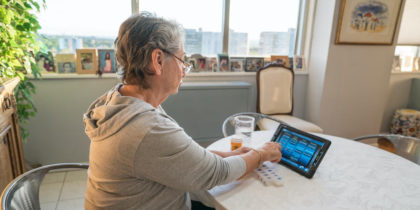The deadline for electronic visit verification (EVV) is fast approaching. Beginning January 1, 2020, home care agencies that provide personal care services (PCS) must have an EVV solution in place or risk having their Medicare and Medicaid claims denied.
Part of the 21st Century Cures Act, which was passed in 2016 with bipartisan support, the EVV mandate is meant to curb healthcare fraud and waste. According to the federal mandate, states must require electronic verification for PCS visits starting next year, and for home healthcare (HHCS) visits by January 1, 2023.
What does this mean for home care agencies? What will it take to be compliant? That depends largely on the state.
What is the EVV mandate?
The 21st Century Cures Act defines electronic visit verification and suggests some possible approaches, but it lets states decide exactly how to gather and report EVV data. In other words, it doesn’t tell states how to create an EVV system for home care — just that they must do it.
States that don’t comply with the EVV mandate could lose up to 1 percent of their Federal Medical Assistance Percentage — the federal government’s contribution to Medicare and Medicaid claims. That means states will have to pay a larger share of the bill.
Several states have already implemented an EVV system, other states are still scrambling to get solutions in place by the 2020 deadline, and many have been granted an additional year to implement a system. The federal mandate provides “limited exception for the first year of the requirement if the state has both made a good faith effort to comply with the EVV requirements and has encountered unavoidable delays in implementation of an EVV system.”
Your Definitive Guide to EVV Compliance
Discover how mobile solutions can can help your agency satisfy EVV requirements in your state. Download Now
More than half the states have already applied for a good faith effort exemption, and others will likely follow suit. However, many of these states already have a plan or even a solution in place and have applied for the extension in order to work out any kinks before they become subject to federal penalties. In other words, just because your state receives an extension doesn’t necessarily mean you have until 2021 to adopt an EVV solution.
(Find out where your state stands in Samsung’s state-by-state compliance guide.)
What is electronic visit verification?
EVV means being able to provide electronic proof of each caregiver visit. At a minimum, an EVV solution must verify:
- Type of service provided
- Individual receiving the service
- Date of service
- Location of service delivery
- Individual providing the service
- Time the service begins and ends
States can require additional information and set their own policies about how and when EVV data should be submitted.
Which services must be electronically verified?
According to the Centers for Medicare & Medicaid Services (CMS), “All services requiring an in-home visit that are included in claims under the home health category or personal care services category on the CMS-64 form are subject to the EVV requirement.”
Simply put, if a personal care or healthcare service is provided in a private home and if Medicaid or Medicare is paying for it, EVV is required. Care services that are provided to hospital inpatients or nursing home residents do not require EVV.
What counts as electronic visit verification?
The federal government has suggested several possible EVV methods but each state gets to decide which are acceptable for the agencies within its borders. These options include:
-
Mobile EVV apps that leverage GPS tracking on caregiver smartphones
-
Interactive voice response (IVR), which allows caregivers to call a toll-free number from the client’s landline phone at the start and end of each visit
-
Fixed devices that remain at a client’s home for the duration of care
States decide which of these methods is acceptable for EVV, and while some states permit all three, other states require one or the other. Most states and agencies are opting for mobile solutions because many people no longer have landline phones, and fixed devices are more costly and burdensome to implement than mobile apps.
Can agencies choose their own EVV solutions?
That depends on which EVV model your state has chosen. There are five possible models:
- State-mandated in-house system: The state develops and operates its own EVV system. (California, Maryland, Mississippi and Oregon will use this model.)
- State-mandated external vendor: States select and contract with a single EVV vendor to implement a state-wide solution. (This is the chosen model for Alabama, Connecticut, Illinois, Kentucky, Nevada, New Mexico, Oklahoma, South Carolina, South Dakota and Texas.)
- Open vendor: States contract with at least one EVV vendor or operate their own in-house system, but also allow providers and managed care organizations (MCOs) to use third-party solutions that meet state and federal requirements. (By far the most popular approach, this model has been adopted by Arizona, Arkansas, Colorado, Delaware, Florida, Georgia, Hawaii, Indiana, Louisiana, Maine, Massachusetts, Michigan, Minnesota, Missouri, Nebraska, New Hampshire, North Carolina, Ohio, Pennsylvania, Rhode Island, Vermont, West Virginia and Wisconsin.)
- Provider choice: Agencies choose their own EVV vendor and fund the implementation. States set EVV standards and data collection requirements. (Utah and Virginia will adopt this model.)
- MCO choice: MCOs select and reimburse EVV vendors. (Tennessee uses this model.)
Most states have selected a vendor because solutions operated by the state or by a state-sponsored vendor qualify for enhanced federal medical assistance percentage (FMAP) matching funds — 90 percent for implementation and 75 percent for ongoing costs, according to the Congressional Research Service.
What happens if agencies fail to comply?
States will deny Medicaid and Medicare claims without electronic visit verification. Enforcement deadlines vary by state.
What are the benefits of EVV for vendors?
The Congressional Budget Office expects EVV systems to save the federal government $290 million over 10 years by preventing Medicaid fraud. That’s great news for taxpayers but what advantage does EVV provide agencies, aside from just compliance?
For smaller agencies that haven’t already invested in mobile solutions, EVV is yet another good reason to embrace digital transformation. With the right software integrations, smartphones can provide agencies with many benefits, including the ability to:
-
Integrate with electronic health records (EHR) so caregivers have mobile access to important client information
-
Communicate with caregivers in the field via multiple channels (talk, text, video)
-
Boost caregiver productivity by enabling real-time charting and documentation
- Convert paper-based workflows into electronic forms that caregivers can submit immediately after a visit
-
Automate timekeeping for payroll
-
Track mileage and other care provider costs
-
Monitor caregiver safety
-
Provide caregivers with turn-by-turn directions to patients’ homes
-
Optimize caregiver schedules and routes for greater efficiency
By deploying smartphones to field workers, home care agencies will be able to do more than just meet the EVV mandate: They can also improve communications and enhance business processes.
In other words, EVV doesn’t have to be just another burdensome government shift for home care agencies. It can also be a timely opportunity to future-proof organizations and equip caregivers with tools that help them work faster and smarter and deliver the best possible patient experience.
Get your free comprehensive guide to how mobile solutions can can help your agency satisfy EVV requirements in your state, or explore affordable EVV compliance solutions from Samsung.







